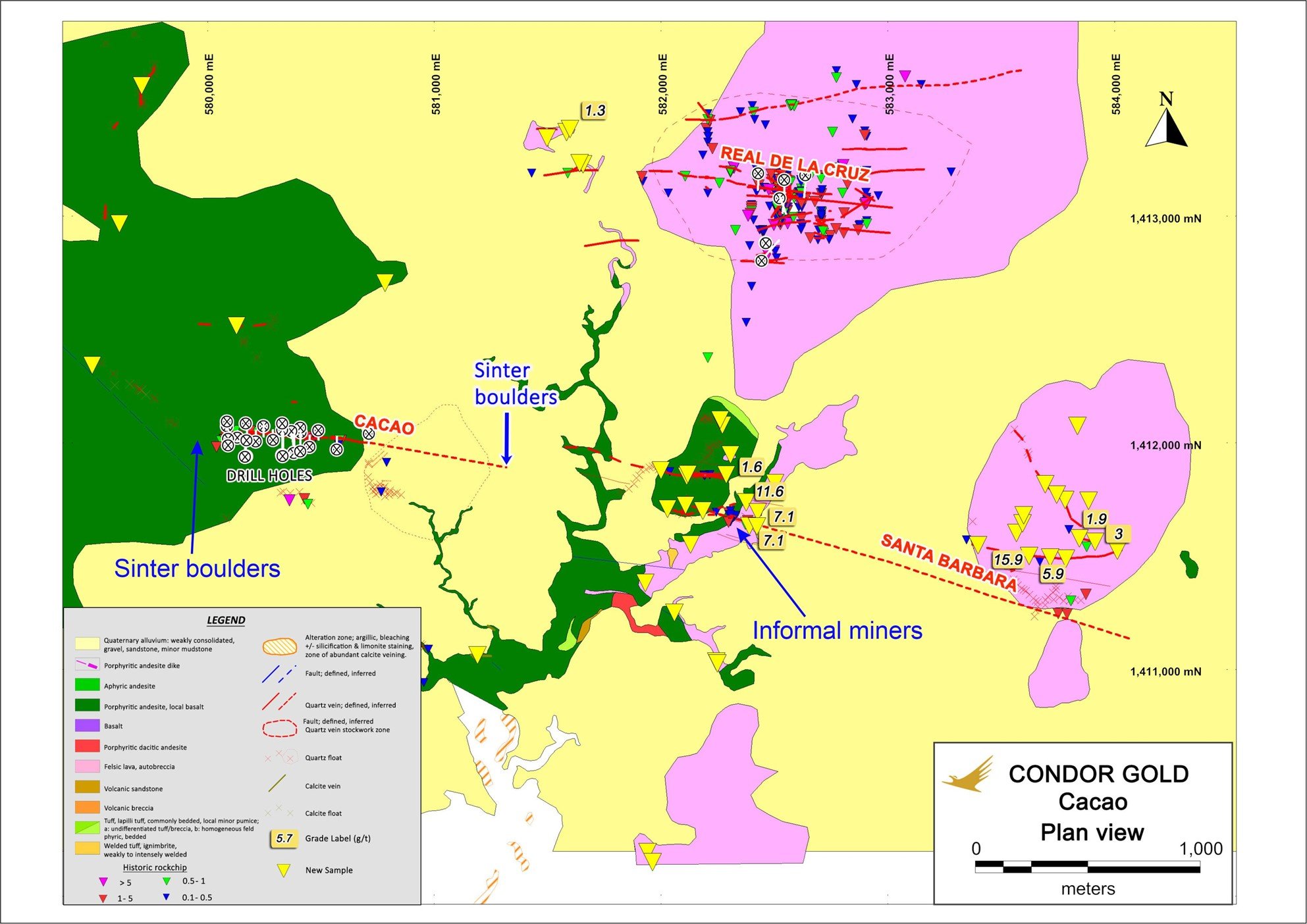Cacao is located approximately 4 km from the planned processing plant at Condor’s fully permitted La India gold mine and is being assessed as a potential satellite deposit.
The Cacao Prospect hosts an Inferred Mineral Resource of 662 Kt at 2.8 g/t gold for 60,000 oz gold based on 2,890m of drilling completed prior to 2018.
The transition from near surface sinters to well developed banded quartz veins, and the associated increase in gold grade that is observed with increased depth fully supports the model that the surface mineralisation at Cacao lies above a fully preserved epithermal system.
The high grade occurs where the matrix of the original fault brecciated quartz vein has been filled by secondary banded quartz, rather than fault gouge clay and sand which infills the breccia in the lower grade parts of the structure.
The latest drilling has now tested approximately 500 m of strike extension immediately to the east of the Cacao Mineral Resource with 100 m spaced drillholes to look for indications of a mineralised structure beneath the alluvial cover.
La India Project contains a Mineral Resource of 9,850 Kt at 3.6 g/t gold for 1.14 Moz gold in the Indicated category and 8,479 Kt at 4.3 g/t gold for 1.18 Moz gold in the Inferred category.
Following the permitting of the Mestiza and America open pits, together with the La India open pit Condor has 1.12 Moz gold open pit Mineral Resources permitted for extraction, inclusive of a Mineral Reserve of 6.9 Mt at 3.0 g/t gold for 675,000 oz gold.
The Mineral Resource Estimate has been completed by Ben Parsons, a Principal Consultant of the Canadian Securities Administrators and as required by the June 2009 Edition of the AIM Note for Mining and Oil & Gas Companies.
The technical and scientific information in this press release has been reviewed, verified and approved by Gerald D.
Forward-looking information is not a guarantee of future performance and is based upon a number of estimates and assumptions of management at the date the statements are made including, among others, assumptions regarding: future commodity prices and royalty regimes; availability of skilled labour; timing and amount of capital expenditures; future currency exchange and interest rates; the impact of increasing competition; general conditions in economic and financial markets; availability of drilling and related equipment; effects of regulation by governmental agencies; the receipt of required permits; royalty rates; future tax rates; future operating costs; availability of future sources of funding; ability to obtain financing and assumptions underlying estimates related to adjusted funds from operations.
Although the Company has attempted to identify important factors that could cause actual actions, events or results to differ materially from those described in forward-looking information, there may be other factors that cause actions, events or results not to be as anticipated, estimated or intended.
Used to refer to zones in the Earth’s crust where hydrothermal fluids change to vaporise .
A fragmental rock, composed of rounded to angular broken rock fragments held together by a mineral cement or in a fine-grained matrix.
That part of a Mineral Resource for which tonnage, densities, shape, physical characteristics, grade and mineral content can be estimated with a reasonable level of confidence.
That part of a Mineral Resource for which tonnage, grade and mineral content can be estimated with a low level of confidence.
A concentration or occurrence of material of economic interest in or on the Earth’s crust in such a form, quality, and quantity that there are reasonable and realistic prospects for eventual economic extraction.
